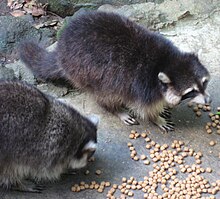Island raccoon

The term island raccoons is used as a generic term for four endangered and one (or two) extinct subspecies or species of raccoon (
- Bahamas
- Barbados raccoon (Procyon lotor gloveralleni): extinct subspecies of the common raccoon endemic on Barbados until 1964
- Cozumel raccoon (Procyon pygmaeus): species endemic on Cozumel
- Basse-Terre Island and Grande-Terre of Guadeloupe, which is assumed to be consubspecific(of the same subspecies) with the Bahamian raccoon
- Tres Marias raccoon (Procyon lotor insularis): subspecies of the common raccoon endemic on the two main islands María Madre and María Magdalena of the Islas Marías, which is probably extinct on María Magdalena (this population is sometimes considered to be a separate subspecies (Procyon lotor vicinus))
Classification
After studies of their morphological and genetic traits in 1999, 2003 and 2005, only the Cozumel raccoon is still considered a distinct species, while the others were classified as subspecies of the common raccoon in the third edition of Mammal Species of the World published in 2005.[2][3][4] It is assumed that the four (or five) other island forms were introduced to their respective islands just a few centuries ago, probably by humans.[2] The Guadeloupe raccoon is even considered of the same species as the similar Bahamian raccoon. Its former scientific name Procyon (lotor) minor is listed as a synonym for Procyon lotor maynardi.[4]
Description
Apart from the comparatively large Tres Marias raccoon, all island raccoons are smaller than an average-sized common raccoon, making them examples of
Conservation
The last sighting of the Barbados raccoon occurred in 1964, when one specimen was killed by a car on a road near
References
- ISBN 978-1-58834-033-7. (This source was used for the whole article unless noted otherwise.)
- ^ .
- ^ ISBN 978-970-32-2603-0. Retrieved 2008-08-09.
- ^ ISBN 978-0-8018-8221-0. Retrieved 2008-08-09.
- )
- ^ Mustelid Specialist Group (1996). "Procyon insularis". IUCN Red List of Threatened Species. 1996. Retrieved 2008-08-10.
- ^ Mustelid Specialist Group (1996). "Procyon maynardi". IUCN Red List of Threatened Species. 1996. Retrieved 2008-08-10.
- ^ Mustelid Specialist Group (1996). "Procyon minor". IUCN Red List of Threatened Species. 1996. Retrieved 2008-08-10.
- . Retrieved 12 November 2021.
- ^ McFadden, Katherine W. (2004). "The Ecology, Evolution and Natural History of the Endangered Carnivores of Cozumel Island, Mexico" (PDF): 85. Retrieved 2008-08-15.
{{cite journal}}: Cite journal requires|journal=(help) (Dissertation at the Columbia University)
